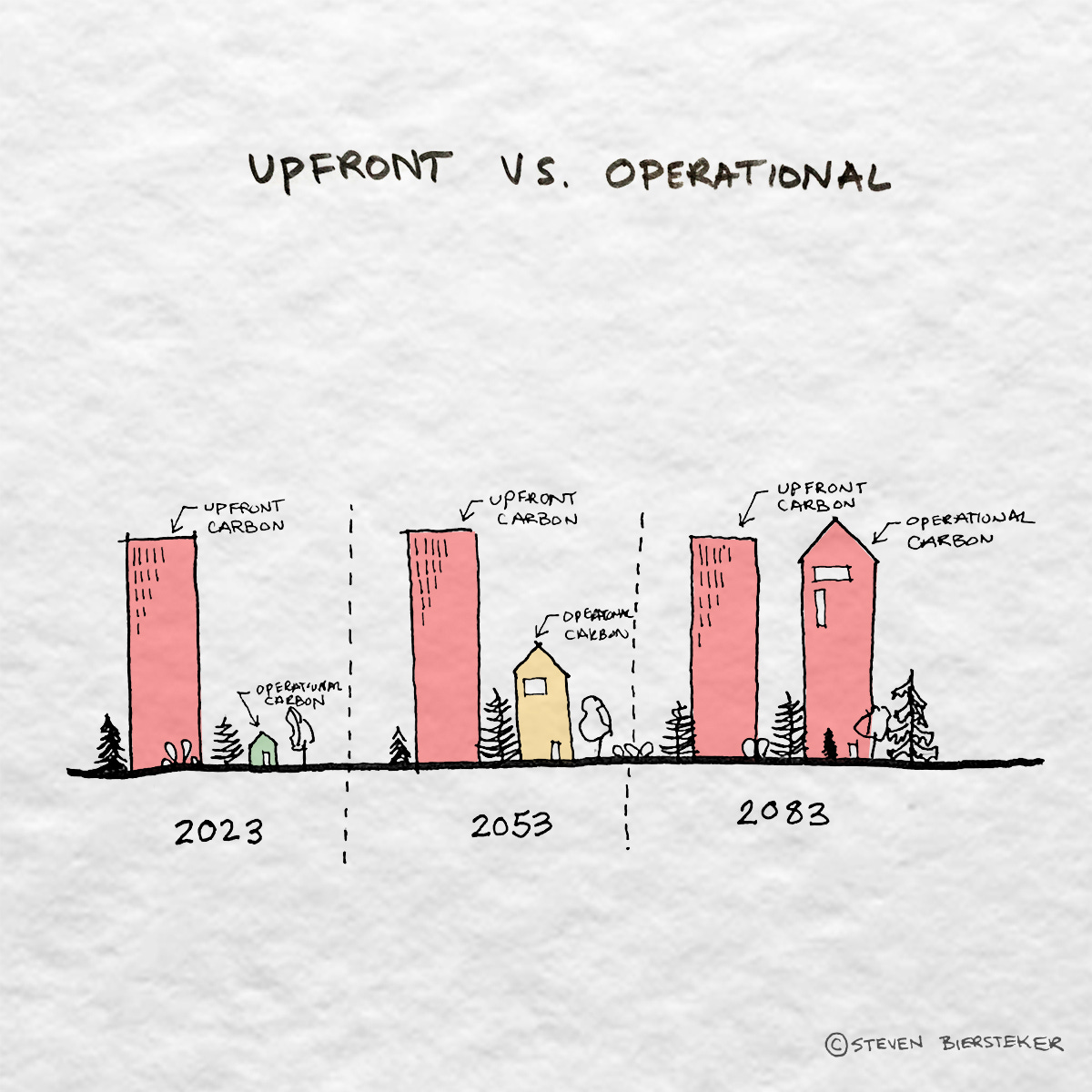CA01 - Upfront Emissions
The elephant in the room.
THE TOPIC - UPFRONT EMISSIONS
By now you’ve probably heard the term – Embodied Carbon.
It is a buzzword in the industry of late and for good reason.
“Embodied carbon is the carbon emissions associated with materials and construction processes through a building’s lifecycle.”1
Said another way - Embodied Carbon is the Green House Gas emissions required to build and maintain a building over its lifecycle.
Lloyd Alter in the Tree Hugger points out the problem with the term Embodied Carbon and suggests we should instead refer to them as Upfront Carbon Emissions. During the making of building materials CO2 is released, not embodied. In fact, embodied carbon (also known as sequestering carbon) is a good thing when we use materials like wood that actually store carbon in the building.
Despite this flaw in terminology, it does paint a clear picture of the problem.
Embodied Carbon – Carbon released to building the building
Operational Carbon – Carbon released to operate the building
A simple and effective way to communicate the two major contributors in a building.
Take a look at this sketch that illustrates the breakdown of upfront vs operational carbon over a high-performance building lifecycle before we dig deeper into the issue.
WHY DOES IT MATTER?
Upfront Carbon matters for three primary reasons:
1. It is a massive contributor to the emissions of buildings.
2. These emissions are happening now, not in the future
3. These emissions are mostly unregulated
Let’s dig a little deeper:
1 – Massive Contributor
The Carbon Leadership Forum suggests that on high-performance buildings the upfront carbon can be up to 50% of the total life-cycle emissions on a building.
Meaning 50% of a buildings total emissions are already released before it starts operating.
So any efforts by users to turn off the lights, reduce their energy use, and be more efficient, are only attacking 50% of the emissions pie and that is stretched over 60 years!
A large carveout here is the glaring issue of your energy grid.
Electrified building with clean electricity – Upfront emissions is a massive percentage
Electrified building with dirty electricity – Upfront emissions isn’t as big of a percentage.
But to me, this doesn’t really matter. Yes it helps us focus on the bigger problem, but even if a building uses dirty energy, it’s still resulting in those upfront emissions. Even if the overall percentage is smaller.
Upfront emissions are a massive contributor to global warming whether your building is operated by clean energy or not.
2 – Now, not future.
Have you ever heard the story about the doubling penny?
Here is how it goes:
Would you rather have a penny today, that doubled every day for 30 days, or 1 million dollars today?
Surprise, surprise – you’re better off taking the penny.
In fact, you are over 4 million dollars better off taking the penny after 30 days.
But what does this have to do with carbon?
This story illustrates the power of two forces - time and compounding.
The same logic is true of carbon emissions … but in reverse.
Imagine rewriting that story but instead of a penny on day one, you get a nickel or a dime.
Then the comparison isn’t even close!
That’s what it’s like with upfront emissions. Every kg of CO2e we put into the atmosphere today isn’t leaving, at least not for a very long time.
What we do NOW has a massive impact on the next 80 years.
Reducing 1kg of CO2e today is way more impactful than 1kg in 30 years.
3 – Unregulated
If you live in a place with a building code, there is a good chance your energy use is regulated.
In modern construction you must meet certain insulation values to build a building.
This establishes a baseline to ensure that all buildings perform to a certain level.
Yes, the bar is very low in many cases, but there is still a bar.
Unfortunately, upfront emissions are like steroids in 1900’s baseball.
They were a big problem, but nobody is doing much about it.
We know upfront emissions are a big issue, but we don’t have a mechanism for controlling them … yet.
There have been signs of embodied carbon regulations as municipalities like Vancouver, Canada begin to address the need on their own terms.
Largely this problem is up to the design and construction industries.
So let’s lead the charge.
1 TIP - HOW TO REDUCE
Upfront emissions can feel like swimming in an ocean. Without a reference point, it’s hard to reduce and measure your building’s carbon footprint.
Start by understanding benchmarks and setting targets for your building.
For example: A benchmark for an Office Building in Canada is ~400kgCO2e/m2
If your building is 100m2, your anticipated upfront emissions would be roughly 40,000kgCO2e or 40 Tonnes.
Now you have a reference point.
1 RESOURCE - TO HELP YOU ACT
Since benchmarks are an important place to start, where can you find them.
The 2017 Carbon Leadership Forum Benchmark Study is a good place to start.
The interactive tool allows you to compare and see upfront emissions from buildings of different types and sizes.
The study is currently being updated, but it gives you a great reference point.
If you know of any more great resources - drop a comment.
https://www.cagbc.org/news-resources/research-and-reports/embodied-carbon/



It's great that you are doing this. Looking forward to more!